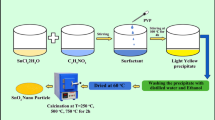Abstract
In this study, a novel SnO2 nanoparticle was successfully synthesized by controlling its surface structure. The surface structure on the nanoparticle is consistent of Pd and PdO clusters of which size is smaller than 1nm. For uniform dispersion of the clusters, in-situ synthetic method was applied using Sn acetate and Pd acetate. The method enhances uniformity by mixing two elements as an aqueous solution. Also, those materials lower the processing temperature since the removal of organic components is possible below 300oC. HRTEM observation reveals that the size of the synthesized particle is ranged from 2 to 7 nm and the Pd cluster is uniformly distributed in the lattice of SnO2 particle. In fact, XRD analysis certifies the uniform solid solution of the Pd cluster in SnO2 since the localized Pd peak was not found. Specific surface area of the synthesized particle measured with BET surface analyzer exceeded 100 m2/g. Also, the SnO2-5wt%Pd nanoparticle exhibits the excellent change in resistance of 0.62 after aging at 400oC for 5 hours. Also, the electrical properties show very stable phenomena in spite of long-term aging for 400 hours at 400oC. So, the ultrafine SnO2-Pd nanoparticle could be synthesized by using the in-situ synthetic method.
Similar content being viewed by others
References
J.H. Kang, J.Y. Kim, and D.Y. Jeon, IDW'02, 44, 1007 (2002)
S.R. Morrison, Sensors and Actuators A, 12, 425 (1987)
G. Blaser, Th. Ruhl, C. Diehl, M. Ulrich and D. Kohl, Physica A, 266, 218 (1999)
M. Schweizer-Berberich, J.G. Zheng, U. Weimar, W. Gopel, N. Barsan, E. Pentia and A. Tomescu, Sensors and Actuators B, 31, 71 (1996)
A. Dieguez, A. Vila, A. Cabot, A. Romano-Rodriguez, J.R. Morante, J. Kappler, N. Barsan, U. Weimar and W. Gopel, Sensors and Actuators B, 68, 94 (2000)
A. Dieguez, A. Vila, A. Cabot, A. Romano-Rodriguez, J.R. Morante, J. Kappler, N. Barsan, U. Weimar and W. Gopel, Sensors and Actuators B, 31, 1 (1996)
A. Diequez, A. R Rodriguez J. R. Morante, U. Weimar, M. S. Berberich and W. Gopel, Sensors and Actuators B, 58, 360 (1999)
N. Yamazoe and T. Seiyama, CH2127-9/85/0000-0376 $1.00© 1985 IEEE, 376 (1985)
Q. Pan, J. Xu, X. Dong and J. Zhang, Sensors and Actuators B, 66, 237 (2000)
G. De, A. Licciulli, C. Massaro, A. Quirini, R. Rella, P. Siciliano and L. Vasanelli, Sensors and Actuators B, 55, 134 (1999)
S.J. Hong and J.I. Han, Sensors and Actuators A, 112, 80 (2004)
Author information
Authors and Affiliations
Rights and permissions
About this article
Cite this article
Hong, SJ., Han, JI. Improvement of Electrical Properties of Tin Oxide Nanoparticle by Controlling Its Surface Structure. MRS Online Proceedings Library 818, 106–111 (2004). https://doi.org/10.1557/PROC-818-M11.42.1
Published:
Issue Date:
DOI: https://doi.org/10.1557/PROC-818-M11.42.1




